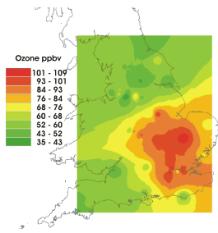Natural organic emissions and summertime UK air quality
Ozone in the lower atmosphere is an air pollutant and a greenhouse gas. The action of light on volatile organic compounds (VOCs) in the atmosphere generates ozone at ground level, resulting in “photochemical smog”. The VOCs are gases that may come from natural or man-made sources. In the UK, air pollutants reduce lifespan on average by about 1 year, and by up to 9 years for the most vulnerable groups with respiratory problems, particularly the elderly and children. Health costs are estimated to be about £11 billion per year.

Starting in 2003, the Natural Environment Research Council supported an experimental project led by Alastair Lewis (also including Lucy Carpenter, Jacqui Hamilton and James Lee from York) to establish which organic compounds increased ozone formation. Lewis made state-of-the-art measurements at different sites in the UK. The research revealed the unexpectedly high level of emissions of VOCs by trees during the hottest periods, catalysing the formation of smog.
The research changed how predictions are made by the Department for Environment Food and Rural Affairs of the effects of emissions of VOCs by vegetation. The Met Office and forecasters have now improved their air quality forecasts provided to the public by adding the effect of natural emissions. Consequently, the York research also helped those people at health risk from low air quality. The impact spanned public policy, environmental policy and health.
For further information on our research in this area please see the Wolfson Atmospheric Chemistry Laboratories page.
